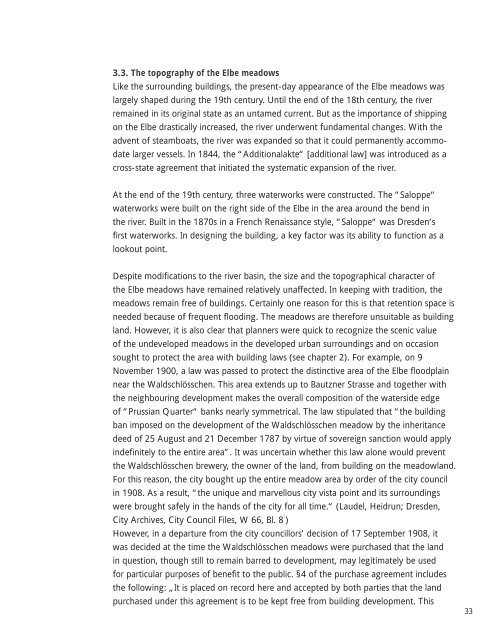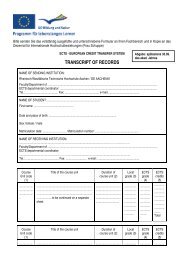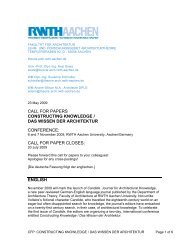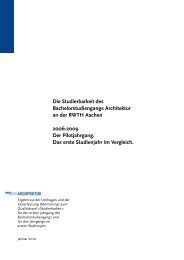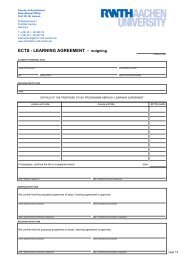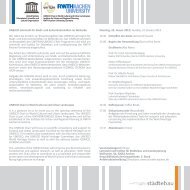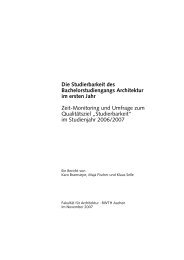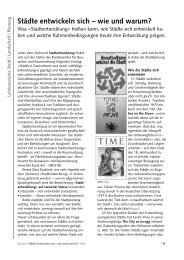Gutachten Dresden_englisch_dritte f.indd - Fakultät für Architektur ...
Gutachten Dresden_englisch_dritte f.indd - Fakultät für Architektur ...
Gutachten Dresden_englisch_dritte f.indd - Fakultät für Architektur ...
Create successful ePaper yourself
Turn your PDF publications into a flip-book with our unique Google optimized e-Paper software.
3.3. The topography of the Elbe meadows<br />
Like the surrounding buildings, the present-day appearance of the Elbe meadows was<br />
largely shaped during the 19th century. Until the end of the 18th century, the river<br />
remained in its original state as an untamed current. But as the importance of shipping<br />
on the Elbe drastically increased, the river underwent fundamental changes. With the<br />
advent of steamboats, the river was expanded so that it could permanently accommo-<br />
date larger vessels. In 1844, the “Additionalakte“ [additional law] was introduced as a<br />
cross-state agreement that initiated the systematic expansion of the river.<br />
At the end of the 19th century, three waterworks were constructed. The “Saloppe“<br />
waterworks were built on the right side of the Elbe in the area around the bend in<br />
the river. Built in the 1870s in a French Renaissance style, “Saloppe“ was <strong>Dresden</strong>‘s<br />
first waterworks. In designing the building, a key factor was its ability to function as a<br />
lookout point.<br />
Despite modifications to the river basin, the size and the topographical character of<br />
the Elbe meadows have remained relatively unaffected. In keeping with tradition, the<br />
meadows remain free of buildings. Certainly one reason for this is that retention space is<br />
needed because of frequent flooding. The meadows are therefore unsuitable as building<br />
land. However, it is also clear that planners were quick to recognize the scenic value<br />
of the undeveloped meadows in the developed urban surroundings and on occasion<br />
sought to protect the area with building laws (see chapter 2). For example, on 9<br />
November 1900, a law was passed to protect the distinctive area of the Elbe floodplain<br />
near the Waldschlösschen. This area extends up to Bautzner Strasse and together with<br />
the neighbouring development makes the overall composition of the waterside edge<br />
of “Prussian Quarter“ banks nearly symmetrical. The law stipulated that “the building<br />
ban imposed on the development of the Waldschlösschen meadow by the inheritance<br />
deed of 25 August and 21 December 1787 by virtue of sovereign sanction would apply<br />
indefinitely to the entire area”. It was uncertain whether this law alone would prevent<br />
the Waldschlösschen brewery, the owner of the land, from building on the meadowland.<br />
For this reason, the city bought up the entire meadow area by order of the city council<br />
in 1908. As a result, “the unique and marvellous city vista point and its surroundings<br />
were brought safely in the hands of the city for all time.“ (Laudel, Heidrun; <strong>Dresden</strong>,<br />
City Archives, City Council Files, W 66, Bl. 8´)<br />
However, in a departure from the city councillors’ decision of 17 September 1908, it<br />
was decided at the time the Waldschlösschen meadows were purchased that the land<br />
in question, though still to remain barred to development, may legitimately be used<br />
for particular purposes of benefit to the public. §4 of the purchase agreement includes<br />
the following: „It is placed on record here and accepted by both parties that the land<br />
purchased under this agreement is to be kept free from building development. This<br />
33


